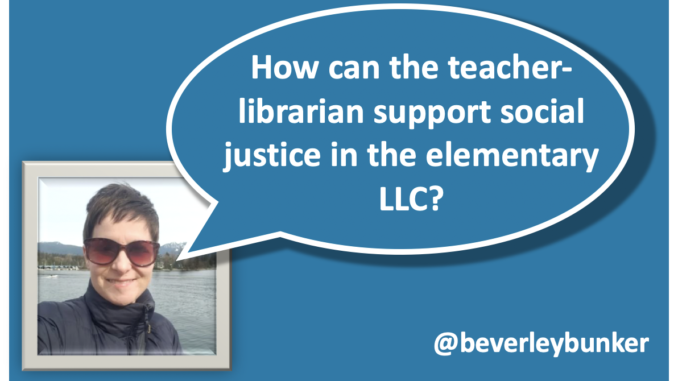
By Beverley Bunker
I’ve always believed in teaching from the heart. As a K-7 educator in both choice and regular programs, I’ve seen the real impact we can have on students’ perceptions of themselves as learners and as human beings. After nine great years in the classroom, I had the immense privilege of working in teacher education for three years. If you have never worked with pre-service teachers, I can tell you that they are some of the most passionate, energetic, and inspirational people I’ve ever met. I loved this work! It fueled my passion for systemic change and showed me that many new teachers were ready to tackle big social challenges.
In this role, I had access to some amazing professional learning opportunities. As someone who was deeply involved with BC’s revised curriculum at the time, I was passionate about inquiry and eager to learn more about the First Peoples’ Principles of Learning. I was fortunate to have amazing colleagues in this domain who were willing to share their authentic perspectives. I started to read more about systemic racism, particularly in the United States, because that is what is often easily accessible. A few of my first reads included Ijeoma Oluo’s So You Want to Talk About Race, Robin DiAngelo’s White Fragility, and Ta-Nehisi Coates’ Between the World and Me. I was fortunate to attend in-person workshops with Dr. Jennifer Katz on Universal Design for Learning and Dr. Robin DiAngelo on white fragility. I started to gain a greater appreciation of my own privilege and my responsibility to engage in anti-racist work. I also started to look inward and explore my own experiences and ignorance growing up.
Owning My Mistake
In my final year, I was teaching a methods course in French as a Second Language for probably the tenth time. I decided to incorporate francophone music into one of my lessons. I asked teacher candidates to move to one of four corners of the room to indicate whether they liked or disliked each song, which represented a variety of francophone cultures from around the world. One of my song choices elicited a strong response from an Indigenous student who I touched base with after class. They explained that they felt the song was an example of cultural appropriation; the title used the name of an Indigenous group while the band members were not Indigenous themselves. They also mentioned that it felt wrong to say they liked or disliked a song without any deeper understanding of its cultural context. Although I felt I was respectful in my response, the conversation sparked some upset from other members of the cohort as well. They voiced their concerns about my response, my lack of care, and the imposition of another colonial language on their people. It goes without saying that the entire conversation was uncomfortable. I think everyone in the room after class walked away upset and hurt that day. Luckily, one brave student approached me the following week and asked if they could take me for coffee to discuss the situation further. I agreed, and the dialogue that followed was one of the most respectful and important conversations I’ve ever had. I feel truly blessed to have met this person and am grateful for what they taught me. After apologizing to the entire cohort, the students who were originally upset said they felt understood and more connected because of the experience.
“Social justice strives against dominance, disrespect, marginalization, exclusion, and non-recognition.”
(Cooke, 2017)
My Next Step
As my secondment in teacher education was coming to an end, I dug deep to explore where I belonged in K-12 education and landed on teacher-librarian. I was drawn in by the leadership potential and the capacity to influence change through collaboration. For the final inquiry in my coursework, I really wanted to dig deep into some of the reasons I chose this path. Inspired by both my own passion for social justice and my experiences in teacher education, I focused on the following question:
How can the teacher-librarian support social justice in the elementary LLC?
The sub-questions below helped to guide my research:
- How can the teacher-librarian be an ally for BIPOC, LGBTQ+ and other marginalized members of the school community?
- What factors should we consider when curating and cataloguing diverse collections?
- How do we create an LLC where all students feel welcome, safe, and valued?
It was a deep dive into many areas of teacher librarianship and the learning commons model. In the end, I had a greater understanding of the existing research around marginalized students and how school libraries can support their needs; however, my most important takeaway was the importance of the role I could and should play in being an active ally. Having made a big mistake and lived through the experience, I was willing to be vulnerable to help others learn.
The Awakening
I grew up in white neighbourhoods
surrounded by white friends.
I grew up in a single parent household
without a lot of money.
On multicultural day, I felt I had no culture
because I was
“just Canadian.”
I did not feel privileged.
I always knew I was heterosexual.
No one has ever questioned my relationships.
Passionately, I told others that LGBTQ+ people were “born that way”
not realizing that this implies they would change
if they could.
I thought I was helping.
I was angry that others got a “free ride” when I deserved it for my
hardships
and my hard work.
I didn’t understand that the system
was rigged.
My skin colour and my sexual orientation
were never a barrier to my success
so…
I grew up blind to my privilege.
I am white.
I am female.
I am an educator.
I have benefited from my privilege.
I am racist.
Why Is It Important?
The number one reason students feel personally unsafe or afraid at school is personal appearance (GLSEN & Harris Interactive, 2020). Indigenous youth frequently experience discrimination and harassment at school, which may contribute to disparities in high school completion and high rates of substance abuse. LGBTQ2S+ youth also experience a disproportionate rate of victimization in schools and often lack access to important resources that would support their well-being (Zongrone et al., 2020). As I engaged in the research, I started to create a vision for how teacher librarians could become active allies who not only create inclusive spaces and collections, but who engage in social justice every day. It is generally understood that K-12 education in Canada is made up of predominantly white cisgender women; as teacher librarians, who interact with our whole school community, we have an extremely important role to play in advocating for equity.
“An ally is someone from a nonmarginalized group who uses their privilege to advocate for a marginalized group. They transfer the benefits of their privilege to those who lack it.”
(Phillips, 2020)
What Can We Do?
First and foremost, we need to engage in ongoing learning. We should not place the burden on marginalized groups to “teach” us about their experiences. We can also speak up for marginalized groups and intervene when we encounter anti-LGBTQ2S+ or racist language in our schools. Zero tolerance for this kind of language in the LLC is a must if we want to ensure it is a safe place for all. Below are 10 practical actions we can take in our library learning commons to support social justice.
- Listen to the community: Ask students what they want to learn. Involve the school community in decisions about the library collection and spaces.
- Be a role model for inclusion: Use gender neutral language such as “they” rather than “he” or “she.” Do not make assumptions about students’ identities based on appearances.
- Make information accessible: Make information about racism, Indigenous and LGBTQ+ issues available and easily accessible at all times – not just for special events.
- Know your district policies: Many districts have policies in place for both the well-being of marginalized students and the curation of library resources. Get to know these policies.
- Teach about equity in the library program: Teach anti-racism and anti-discrimination practices. Teach LGBTQ+ and Indigenous content. Embed the First Peoples’ Principles into library lessons.
- Teach critical literacy: Ask important questions to help students examine bias in literature as well as whose voices are not present. Ask them what they think this means.
- Create inclusive book displays: Prioritize the inclusion of LGBTQ+ and BIPOC authors and characters in book displays, especially when the theme is not related to oppression. Normalize diversity.
- Make the LLC a visible “safe space”: Many districts offer training to support allies and anti-racism. Participate and then put up a sticker in the library so students know it is a safe space.
- Make the space available: If your school has a GSA or rainbow club, offer the LLC as a meeting space. Help facilitate. Connect with community groups to host events in the LLC.
- Own your mistakes: We will all make mistakes. Own them, apologize where appropriate, and learn from the experience. When you’re afraid, ask yourself whether your own comfort is more important than the rights of marginalized groups.
“The library is for everyone, a window to the wider world, and a safe place to inspire all learners and build relationships. School libraries and teacher-librarians… are perfectly placed to take leadership with our teaching colleagues, modelling culturally relevant and inclusive learning, and shifting school culture.”
(Brooks Kirkland, 2018)
First Year in the Library Learning Commons
As a new teacher-librarian in a K-7 elementary school, I’ve spent this year getting to know my school community and collection. I’ve engaged in significant weeding and participated in our school district’s picture book diversity audit. I’ve made a conscious effort to purchase more fiction with South Asian characters to better reflect our student population; I’m also trying to be more cognizant of intersectionality when selecting new resources.
This year, I’ve worked with what we have, to create a space that feels warm and welcoming. I have a plan in place to slowly revitalize our learning commons space so that it better reflects our students’ identities and encourages them to use the space for learning, connection, and rejuvenation. We’re almost finished genrefying our fiction and we’ve introduced more baskets to help younger students find what they’re looking for more easily.
We are a large school with a fixed schedule for K-3 classes and limited time for Gr. 4-7 students to visit the LLC. This year, I’ve incorporated a wide variety of picture books into our K-3 library program that address issues of equity and represent a wide variety of people. We often use loose parts to show and share our thinking.
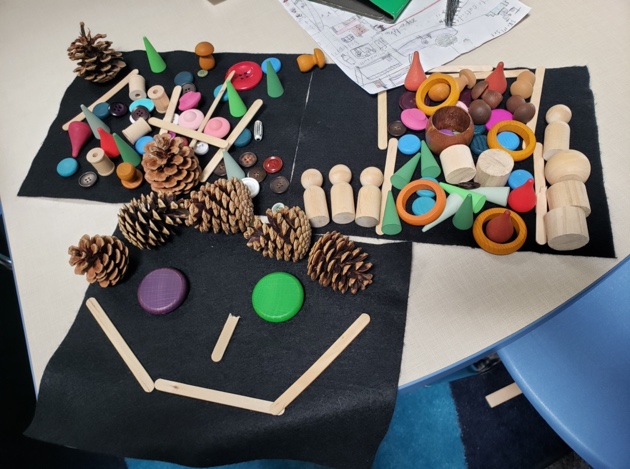
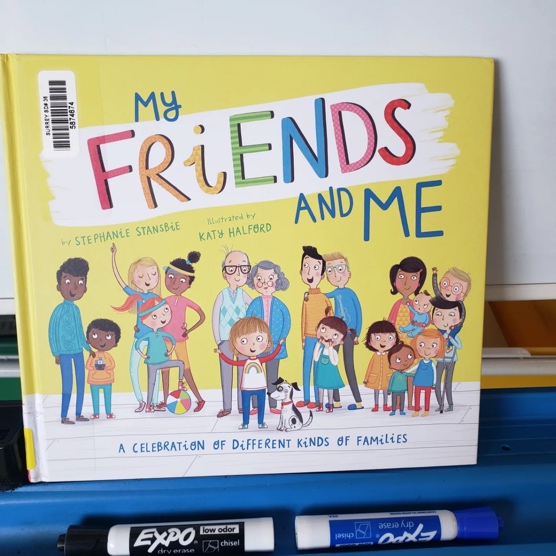
“I’m Filipino, so we have a few big celebrations where we make lots of food to share because we have to remember to be thankful for God. These are all of the people in my family eating together and the big smile is me because it makes me happy.”
Learner in Grade 2
Early in the year, I noticed that our student population did not gravitate toward Indigenous resources; after creating a visible space for them, K-3 students are now self-selecting these picture books, and circulation has increased. I’ve also experimented with outdoor learning as a way to meaningfully incorporate the First Peoples’ of Learning and inspire student inquiry.
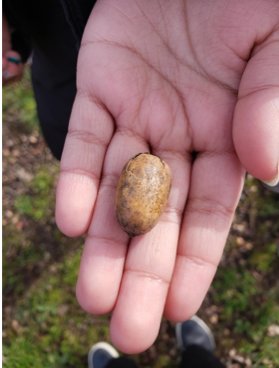


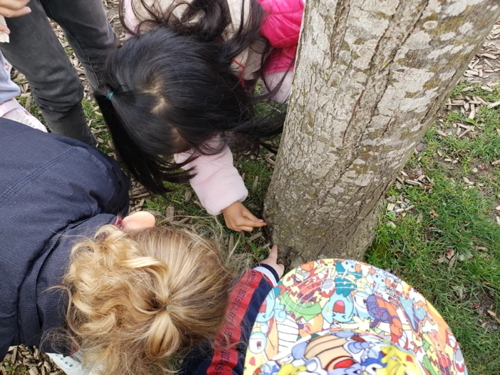
Looking ahead to next year, I’m exploring creative ways to increase access to the physical space, such as team-teaching multiple classes at once to free up more time. I also have plans to provide more asynchronous digital options to support literacy and research skills in intermediate grades. Hopefully this will empower students to access the information that they need rather than always relying on the teacher-librarian. Starting in September, I also hope to implement self-checkout and to become more involved in our school’s Rainbow Club so that students can maintain their privacy and know that I am a safe person in the school.
Conclusion
I’m very grateful to have engaged in my inquiry; the opportunity presented itself at exactly the right time in my professional learning journey. My previous experiences led me to my wonder and the research fueled my passion as I transitioned into the role of teacher-librarian. My first year in the role has been filled with lots of joy, healthy self-doubt, and deep reflection. There’s a long road ahead, but I’m excited to see what the future brings.
Works Cited
Brooks Kirkland, Anita. “The Truth in Our Stories: Culturally Inclusive and Relevant Library Learning Commons.” Synergy, vol. 16, no. 2, May 2018, https://www.slav.vic.edu.au/index.php/Synergy/article/view/v16220183.
Cooke, Nicole A. “Librarians as Active Bystanders: Centering Social Justice in LIS Practice.” ATLA Spring 2017 Webinar Series, ATLA, 2017, https://vimeo.com/210659589.
GLSEN & Harris Interactive. “Playgrounds and Prejudice: Elementary School Climate in the United States, A Survey of Students and Teachers.” GLSEN, New York, 2012, https://www.glsen.org/sites/default/files/2019-11/Playgrounds_and_Prejudice_2012.pdf.
Phillips, Holiday. “Performative Allyship Is Deadly (Here’s What To Do Instead).” Forge @ Medium, 9 May 2020, https://forge.medium.com/performative-allyship-is-deadly-c900645d9f1f.
Zongrone, Adrian et al. “Erasure and Resilience: The Experiences of LGBTQ Students of Color, Native American, American Indian, and Alaska Native LGBTQ Youth in U.S. schools.” New York, GLSEN, 2020, https://www.glsen.org/sites/default/files/2020-06/Erasure-and-Resilience-Native-2020.pdf.
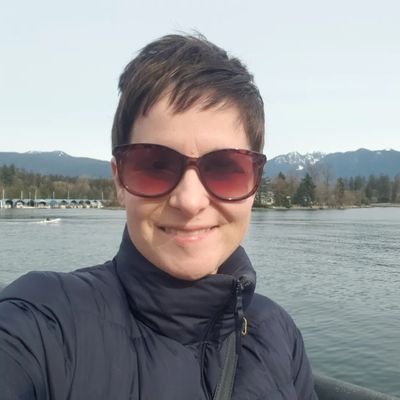
Beverley Bunker (she/her) is a K-7 teacher-librarian in Surrey, BC. She has 13 years of experience in education, including three as the SEL Cohort Coordinator at the University of British Columbia. Professionally, she is passionate about inquiry, equity, assessment that empowers learners, and social emotional learning. Beverley recently took on the role of teacher-librarian because she believes we play a pivotal role in radically transforming school environments and learning experiences. Outside of school, you will probably find her reading, drinking tea, enjoying the beach or the forest, and singing alongside her toddler. You can follow her musings and adventures @beverleybunker and @WHIL36_library.